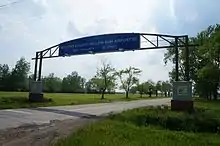Willow Run Airport
Willow Run Airport (IATA: YIP, ICAO: KYIP, FAA LID: YIP) is an airport in Van Buren Charter Township and Ypsilanti Township,[2][3] near Ypsilanti, Michigan, United States, and serves freight, corporate, and general aviation. Due to its proximity to Detroit Metropolitan Airport, no major airlines schedule passenger flights to or from Willow Run.
Willow Run Airport (YIP) | |||||||||||||||||||
|---|---|---|---|---|---|---|---|---|---|---|---|---|---|---|---|---|---|---|---|
 | |||||||||||||||||||
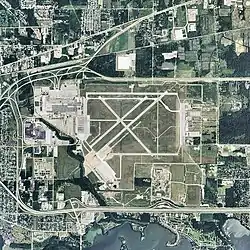 2006 USGS photo | |||||||||||||||||||
| Summary | |||||||||||||||||||
| Airport type | Public | ||||||||||||||||||
| Operator | Wayne County Airport Authority | ||||||||||||||||||
| Location | Van Buren Charter Township and Ypsilanti Township | ||||||||||||||||||
| Elevation AMSL | 716 ft / 218 m | ||||||||||||||||||
| Coordinates | 42°14′16.539″N 83°31′49.47″W | ||||||||||||||||||
| Map | |||||||||||||||||||
 YIP Location of airport in Michigan  YIP YIP (the United States) | |||||||||||||||||||
| Runways | |||||||||||||||||||
| |||||||||||||||||||
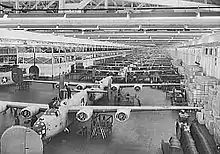
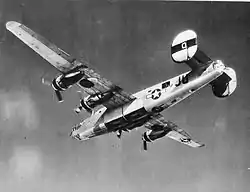
It is included in the Federal Aviation Administration (FAA) National Plan of Integrated Airport Systems for 2017–2021, in which it is categorized as a national reliever airport facility.[4]
Opened in 1942, "Willow Run" was synonymous with the American industrial effort that contributed so much to Allied victory in World War II. Operated by the Ford Motor Company, the Willow Run manufacturing plant produced a total of 8,685 B-24 Liberator heavy bombers, completed and in kit form, before closure in April 1945; Willow Run produced more Liberators than either plant owned by the plane's designer, Consolidated Aircraft.
Today the Yankee Air Museum, in one of the airport hangars, has a large collection of vintage aircraft.
Overview
Willow Run Airport covers 2,600 acres (1,100 ha) and has three runways, a continuously staffed FAA control tower, and US Customs operations.[1] It is one of two facilities operated by the Wayne County Airport Authority, the other being Detroit Metropolitan Airport, which replaced Willow Run as the major commercial airport for the region starting in 1958. Worldwide cargo airlines Kalitta Charters and National Airlines are based at Willow Run Airport.
History

Willow Run Airport was named for a small stream that meandered through pastureland and woods until the late 1930s. Automobile pioneer Henry Ford bought the property that became the airport's runways and taxiways in 1931,[5] and used it for almost a decade as farmland for a "social engineering" experiment that brought inner-city boys to Willow Run Farm to learn about nature, farming tasks, and the rural way of life. The residents at the Willow Run farms planted, tended, and harvested crops as well as running a maple syrup operation, and sold their products at the farm market on the property. In the process, the boys learned self-discipline and the values of hard work, and benefited from the fresh air that they had not been able to experience while growing up in congested cities.[6]
World War II
See the Willow Run article for further details of manufacturing at the site.
The coming of World War II to Europe and the Fall of France in 1940 alarmed many in the United States, and in spite of an official policy of American neutrality, a number of government officials began preparing for the possibility of United States involvement. Henry Ford, himself an isolationist, was prevailed upon in the spring of 1941 to accept a contract to build B-24 Liberator heavy bombers for the Army Air Forces, under license from the plane's designer Consolidated Aircraft. He chose as the site his Willow Run Farm and commenced building a massive industrial plant that became the Willow Run manufacturing complex. Architect Albert Kahn designed the main structure, which had 3,500,000 sq ft (330,000 m2) of factory space, and an aircraft assembly line over 1 mi (1.6 km) long. It was thought to be the largest factory under one roof anywhere in the world.[6]
To meet projected demand for the B-24, in early 1941 the Federal government established the Liberator Production Pool Program; Ford joined the program shortly thereafter. Although the Ford Trimotor had been a success in the 1920s, the company had since shied away from aviation, and initially, Ford was assigned to provide B-24 components with final assembly performed by Consolidated at its Fort Worth plant, or by fellow licensee Douglas Aircraft at its Tulsa, Oklahoma, plant. However, in October 1941 Ford received permission from Consolidated and the Army to assemble complete Liberators on its own at its new Willow Run facility.[7][8] Even then it would take nearly a year before finished Liberators left the factory.
The Willow Run plant was gigantic. It covered 65 acres (26 ha) and was almost a 0.25 mi (0.40 km) wide and 0.5 mi (0.80 km) long . The production line had a 90-degree turn at roughly its two-thirds mark; overhead views suggest this was to avoid encroaching on the airfield's taxiways, while others contend that Ford's construction managers sought to keep the plant and its equipment inside Washtenaw County, where property tax assessments were lower than neighboring Wayne County.[9]
Liberator production
The first Ford-built Liberators rolled off the Willow Run line in September 1942; these were designated B-24E. Few if any of these saw combat, being used instead in training squadrons.[7][10]
The Willow Run bomber plant had many problems at startup, due in part to the mindsets and technical skills of both management and labor, who were each accustomed to the requirements of auto production, finding it difficult at first to adapt to the higher precision required in aircraft production.[11] The plant at Willow Run had labor problems, in particular high absentee rates and rapid employee turnover; the factory was nearly an hour's drive from Detroit, and the imposition of wartime gasoline and tire rationing had made the daily commute difficult. In one month Ford had hired 2900 workers but had lost 3100.[7][8] Ford officials were as a rule anti-union, and Willow Run experienced one serious strike.[7][8][12]
Willow Run transitioned to production of the B-24H in June 1943; these were the first Willow Run Liberators to see combat in numbers. After another year, by which time the factory had begun producing the B-24J (from April 1944),[7][10] the Army determined that Consolidated's San Diego plant and Willow Run could meet future requirements for Liberators. The Boeing B-29 Superfortress was taking over the long-range bombing mission in the Pacific theater and no new B-24 units were programmed for deployment in the Europe, the Mediterranean or in the CBI, the other theatres of the war.[10]
By fall 1944 Willow Run had moved from the B-24L to the B-24M, the last Liberator to be built in significant numbers. Willow Run shut down production in May 1945, after the end of the war in Europe; 6,972 Liberators had been built at Ford, and 1,893 sets of knock-down parts were provided to Consolidated and Douglas for assembly, for a total of 8,685 aircraft.[7][8]
Army Air Forces support and post-production activities
At the request of the government, Ford began to decentralize operations and many parts were assembled at other Ford plants as well as by the company's sub-contractors, with the Willow Run plant concentrating on final aircraft assembly. Ford's production managers coordinated their activities with an Army Air Forces support unit, the 484th Base Headquarters and Base Squadron.[13] The bugs were eventually worked out of the manufacturing processes, and by 1944, Ford was rolling a Liberator off the Willow Run production line every 63 minutes, 24 hours a day, 7 days a week.
After their manufacture, the next step in the process was the delivery of the aircraft to the squadrons. This was done at Willow Run by 1st Concentration Command (1st CC). The 1st CC was responsible for completing the organization and equipment of tactical and combat bombardment squadrons prior to their deployment to the overseas combat theaters. It also provided a final inspection of the aircraft and make any appropriate final changes; i.e., install long-range fuel tanks, remove unnecessary equipment, and give it a final flight safety test.[14][15]
While the planes were being serviced and made ready for overseas movement, personnel for these planes were also being processed. Pilots, co-pilots, navigators and crew chiefs were assigned as a crew for each aircraft. Paperwork was handled, necessary specific B-24 life support equipment was issued and some technical training for supporting the aircraft accomplished.[14][16]
Once production began, it became difficult to introduce changes dictated by field experience in the various overseas theaters onto the production line in a timely fashion. Consequently, newly constructed Liberators needed modifications for the specific geographic areas they were to be flown in combat. For this reason, a series of Air Technical Service Command modification centers were established for the incorporation of these required theater changes into new Liberators following their manufacture and assignments. There were seven known modification centers: Consolidated/Fort Worth; Oklahoma City Air Materiel Center at Tinker Field, Tucson Modification Center at Davis-Monthan Field; the Birmingham Depot in Alabama; the Northwest Airlines Depot in Minneapolis, Minnesota; the, Martin-Omaha manufacturing plant, and the Hawaiian Air Depot at Hickam Field.[7][8]
Ownership changes
Although the airfield itself and the buildings to the east of the runways had been built on Henry Ford's personal property, it is unclear how the parcels across the county line that became the site of the bomber plant were assembled. In any event, Henry Ford (who, although technically retired from Ford Motor operations until Edsel's death from ungulant fever in 1943, still held a say in company affairs) had insisted on building the factory without government financing. Instead, the company built the factory, and sold it to the Reconstruction Finance Corporation's Defense Plant Corporation (RFC-DPC), which then leased it back to Ford for the duration of the war.[17] The land which held the airfield was transferred from Henry Ford's control to that of the company in July 1944, and sold to the RFC-DPC shortly thereafter.[18]
Postwar history
See also Willow Run Transmission and Willow Run Assembly.
Willow Run as Detroit's commercial airport
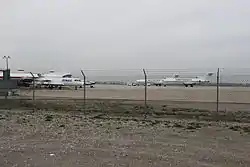
Between 1946 and 1947, passenger airlines serving Detroit moved from Detroit City Airport on the city's crowded east side, to Willow Run; shortly thereafter, Wayne County officials began expanding Detroit-Wayne Major Airport at Romulus, which was 10 mi (16 km) closer to Detroit than Willow Run.[19]
Willow Run's relative isolation encouraged new approaches to passenger transportation to and from airports; at Willow Run in 1946, Warren Avis founded Avis Airlines Rent a Car Systems, the first rental car operation at an airport.
The RFC sold the airport to the University of Michigan in 1947 for $1.00. The terms of the sale required that the university operate the airport as a research facility, and the Michigan Aeronautical Research Center (later renamed Willow Run Research Center) took over some of the airport's buildings that were not needed for commercial aviation operations. For a time, the university housed some of its students in the apartments previously used by plant workers. Many of the buildings at the airport were used by University of Michigan physicists and engineers in research for national defense, including early work in antiballistic missile defense and remote sensing, at a facility which would become the Environmental Research Institute of Michigan (ERIM) after separating from the university in 1972.[6]
At about the same time it sold the airfield, the RFC leased (and later sold) the bomber plant to the Kaiser-Frazer automobile company; the factory eventually became owned by General Motors. The last GM operations at Willow Run ended in 2010, and that property is planned for redevelopment after 2013 by its owner the RACER Trust. Since April 2013, there is an effort underway by preservationists to save a small portion of the original bomber plant facility, adjacent to the airport, as a new home for nearby Yankee Air Museum. The campaign is called SaveTheBomberPlant.org and is centered on a website of the same name.[20]
Decline of Willow Run
Almost all of Detroit's scheduled airline flights used Willow Run until 1958, when the coming of the Jet Age drove traffic to the Romulus airfield, which that year had been renamed Detroit Metropolitan Wayne County Airport (the name it still bears). It offered carriers a new terminal designed for the new aircraft, a newly expanded runway layout, and approach controls that made it the first inland airport in the country certified for jet airliners.[19]
In 1956, there were seven passenger airlines at Willow Run. The April 1957 Official Airline Guide shows 68 weekday departures on Capital, 45 on American, 23 on Eastern, 17 on Northwest Orient, 14 on United, 13 on North Central, 13 on TWA, 8 on Delta, 5 on Allegheny and 3 on Mohawk. American's only westward non-stops were to Chicago; United had a nonstop DC-7 to Los Angeles; come summer TWA would resume its weekly two-stop Constellation flight to Paris, via Gander in Newfoundland and Shannon in Ireland. Only BOAC and Pan Am flew out of Detroit-Wayne Major.
Airline flights ended in 1966 when United, TWA, Eastern, North Central, Mohawk and Lake Central moved to Metro Airport. In 1968, upon hearing that Detroit Tigers fans had overwhelmed Metro Airport in order to greet the newly crowned World Champions, the jet carrying the team diverted to Willow Run instead.[21]
USA Jet, a charter airline, has brought flights back to Willow-Run, on DC-9s and MD-82s.
United States Air Force use
In 1951, the United States Air Force exercised a right of return to Willow Run and established Willow Run Air Force Station to the east of the airport runway. Willow Run AFS closed in 1959.
The airport today

In 1977, the University of Michigan sold the airport to Wayne County for $1.00.[6] The county transferred its airport operations, encompassing both Willow Run and Detroit Metro, in 2004 to the Wayne County Airport Authority, which manages both airports to this day.
An all-cargo airline known as Kalitta Charters now uses Ypsilanti Willow Run Airport as its home base; Conrad "Connie" Kalitta is the owner, and lives locally.
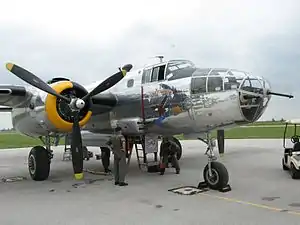
The Yankee Air Museum opened on the airport grounds in 1981. A fire in October 2004 destroyed the museum's building and most of its artifacts. The static display aircraft, including a B-52 Stratofortress and other aircraft too large for display inside the hangar, were undamaged. In 2005 the museum moved to the other side of the airport, where they began to rebuild their displays and gather more World War II memorabilia. In 2013, reports emerged of negotiations between the museum and the RACER Trust that would see the museum into a section of the former bomber plant.[22]
The Yankee Air Museum hosts semi-annual airshows over Willow Run, featuring the Blue Angels.[23][24]
Between July and September 2009, what was Runway 9R/27L along the southern edge of the airfield was converted to Taxiway H. This allowed the redesign of the southwest end of Runway 5R to reduce the possibility of encroachment by taxiing aircraft.[26]
In 2011, Michigan State University planted 3 acres (1.2 ha) of canola and mustard seed on airport property to generate biofuels for aircraft use. The airport has 1,700 acres (690 ha) available for future crop production.[27]
Until 2015, the airport was home to the sole aircraft of Baltia Airlines, an airline that has been attempting to commence operations to St Petersburg since 1991. The aircraft was a Boeing 747-200 with registration N706BL (msn 21705).
On March 8, 2017, a plane carrying the Michigan Wolverines men's basketball team to the Big Ten Conference men's basketball Tournament abandoned takeoff and skidded off the runway in high winds. The plane suffered extensive damage and some of the players suffered minor injuries but no serious injuries or fatalities were reported; while the team arrived late and initially had to play in practice gear (their regular uniforms, like all other luggage, had to remain on the plane as part of the NTSB investigation[28]). They would go on to win the tournament.
See also
References
![]() This article incorporates public domain material from the Air Force Historical Research Agency website http://www.afhra.af.mil/.
This article incorporates public domain material from the Air Force Historical Research Agency website http://www.afhra.af.mil/.
- FAA Airport Form 5010 for YIP PDF, effective June 21, 2018.
- "Township Map" Archived 2005-11-09 at the Wayback Machine. Ypsilanti Township. Retrieved on June 22, 2009.
- "Van Buren township, Wayne county, Michigan". U.S. Census Bureau. Retrieved on October 28, 2009.
- "List of NPIAS Airports" (PDF). FAA.gov. Federal Aviation Administration. 21 October 2016. Retrieved 25 November 2016.
- Bryan, Ford Richardson (1997). Beyond the Model T: The Other Ventures of Henry Ford. Detroit: Wayne State University Press. p. 116, note 8. ISBN 081432682X.
- History of Willow Run Airport Archived 2014-02-21 at the Wayback Machine
- Lloyd, Alwyn T. (1993), Liberator: America's Global Bomber, Pictorial Histories Publishing Co, Inc, ISBN 0-929521-82-X
- O'Leary, Michael, (2003), Consolidated B-24 Liberator (Osprey Production Line to Frontline 4), Osprey Publishing, ISBN 1-84176-023-4
- Herman, Arthur. Freedom's Forge: How American Business Produced Victory in World War II, p. 229, Random House, New York, NY, 2012. ISBN 978-1-4000-6964-4.
- Davis, Larry, (1987), B-24 Liberator in Action - Aircraft No. 80, Squadron/Signal Publications Inc. ISBN 0-89747-190-3
- Herman, Arthur. Fredom's Forge: How American Business Produced Victory in World War II, pp. 219-235, Random House, New York, NY, 2012. ISBN 978-1-4000-6964-4.
- Herman, Arthur. Freedom's Forge: How American Business Produced Victory in World War II, pp. 228-44, Random House, New York, NY, 2012. ISBN 978-1-4000-6964-4.
- "AFHRA Document 00040325". Airforcehistoryindex.org. 1983-08-16. Retrieved 2018-06-23.
- Preparing C-47s for War (Baer Field) Archived 2011-10-05 at the Wayback Machine
- "AFHRA Document 00155775 1 Concentration Command History". Airforcehistoryindex.org. Retrieved 2018-06-23.
- "AFHRA Document 00150138 AAFTC Technical Training Command". Airforcehistoryindex.org. 1943-10-15. Retrieved 2018-06-23.
- Hess, Jerry N. "Oral History Interview with John W. Snyder (Executive Vice-President and Director, Defense Plant Corporation, 1940-43; Assistant to the Director of the Reconstruction Finance Corporation, 1940-44), 10 January 1968". Harry S. Truman Library and Museum. Retrieved 19 May 2013.
- Bryan, Ford Richardson (1997). Beyond the Model T: The Other Ventures of Henry Ford. Detroit: Wayne State University Press. p. 116. ISBN 081432682X.
- "DTW Airport History". Wayne County Airport Authority. Archived from the original on 4 February 2009. Retrieved 25 April 2013.
- "Willow Run bomber plant preservationists get more time to reach goal". Retrieved 26 October 2013.
- "Battle Creek Enquirer, October 11, 1968". Newspapers.com. 1968-10-11. Retrieved 2018-06-23.
- Bomey, Nathan (April 23, 2013). "Former GM Willow Run plant may be demolished". Detroit Free Press. Retrieved 23 April 2013.
- "Thunder Over Michigan 2013". Yankee Air Museum. Retrieved 22 June 2013.
- "YPSILANTI TWP: Blue Angels back for Thunder Over Michigan this weekend". The Ypsilanti Courier. 20 July 2011. Retrieved 22 June 2013.
- "IFR lesson 10: 4 approaches, 1 blown tire". Cleared for the Option. anonymous. Retrieved 25 April 2013.
- General Aviation News. 8 July 2011. Missing or empty
|title=(help) - "Michigan stuck wearing practice uniforms vs. Illinois after plane accident". MLive.com. 2017-03-09. Retrieved 2018-06-23.
- "Rad Lab History". Retrieved July 17, 2005.
- Olivia Murray. "Once Upon a Time in Willow Run". Michigan Today. Archived from the original on 2005-11-20. Retrieved July 17, 2005.
External links
| Wikimedia Commons has media related to Willow Run Airport. |
- Willow Run Airport
- FAA Airport Diagram (PDF), effective January 28, 2021
- Resources for this airport:
- FAA airport information for YIP
- AirNav airport information for KYIP
- ASN accident history for YIP
- FlightAware airport information and live flight tracker
- NOAA/NWS weather observations: current, past three days
- SkyVector aeronautical chart, Terminal Procedures
- Save The Bomber Plant - information and fundraising site for Yankee Air Museum's effort to save a portion of the Willow Run Bomber Plant
